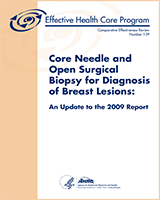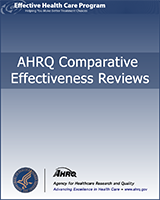NCBI Bookshelf. A service of the National Library of Medicine, National Institutes of Health.
Excerpt
The large number of possible methods of performing breast biopsy can be bewildering to patients and health care providers alike. Which method should one choose? Is a particular method clearly superior, or does the method of choice depend upon individual patient characteristics? We have performed a systematic review intended to evaluate the accuracy of different methods of performing breast biopsy and to explore what factor(s) may impact the accuracy and possible harms of different methods of performing breast biopsy.
Contents
- Preface
- Acknowledgments
- Executive Summary
- 1. Introduction
- 2. Methods
- 3. Results
- Question 1 In women with a palpable or non-palpable breast abnormality what is the accuracy of different types of core-needle breast biopsy compared with open biopsy for diagnosis?
- Question 2 In women with a palpable or non-palpable breast abnormality, what are the harms associated with core-needle breast biopsy compared to the open biopsy technique in the diagnosis of breast cancer?
- Question 3 How do open biopsy and various core-needle techniques differ in terms of patient preference, availability, costs, availability of qualified pathologist interpretations, and other factors that may influence choice of a particular technique?
- Previously Published Systematic Reviews
- 4. Discussion
- References and Included Studies
- List of Acronyms/Abbreviations
- Glossary of Selected Terms
- Appendixes
Prepared for: Agency for Healthcare Research and Quality, U.S. Department of Health and Human Services.1 Contract No. 290-02-0019. Prepared by: ECRI Institute Evidence-based Practice Center.
Suggested citation:
Bruening W, Schoelles K, Treadwell J, Launders J, Fontanarosa J, Tipton K. Comparative Effectiveness of Core-Needle and Open Surgical Biopsy for the Diagnosis of Breast Lesions. Comparative Effectiveness Review No. 19. (Prepared by ECRI Institute Evidence-based Practice Center under Contract No. 290-02-0019.) Rockville, MD: Agency for Healthcare Research and Quality. December 2009. Available at: www.effectivehealthcare.ahrq.gov/reports/final.cfm.
This report is based on research conducted by the ECRI Institute Evidence-based Practice Center (EPC) under contract to the Agency for Healthcare Research and Quality (AHRQ), Rockville, MD (Contract No. 290-02-0019). The findings and conclusions in this document are those of the authors, who are responsible for its contents, and do not necessarily represent the views of AHRQ. No statement in this report should be construed as an official position of AHRQ or of the U.S. Department of Health and Human Services.
The information in this report is intended to help clinicians, employers, policymakers, and others make informed decisions about the provision of health care services. This report is intended as a reference and not as a substitute for clinical judgment.
This report may be used, in whole or in part, as the basis for development of clinical practice guidelines and other quality enhancement tools, or as a basis for reimbursement and coverage policies. AHRQ or U.S. Department of Health and Human Services endorsement of such derivative products may not be stated or implied.
None of the investigators has any affiliations or financial involvement that conflicts with the material presented in this report.
- 1
540 Gaither Road, Rockville, MD 20850. www
.ahrq.gov
- Review Screening for Colorectal Cancer: An Updated Systematic Review[ 2008]Review Screening for Colorectal Cancer: An Updated Systematic ReviewWhitlock EP, Lin J, Liles E, Beil T, Fu R, O'Connor E, Thompson RN, Cardenas T. 2008 Oct
- Review Screening for Skin Cancer in Adults: An Updated Systematic Evidence Review for the U.S. Preventive Services Task Force[ 2016]Review Screening for Skin Cancer in Adults: An Updated Systematic Evidence Review for the U.S. Preventive Services Task ForceWernli KJ, Henrikson NB, Morrison CC, Nguyen M, Pocobelli G, Whitlock EP. 2016 Jul
- Review Supplemental Screening for Breast Cancer in Women With Dense Breasts: A Systematic Review for the U.S. Preventive Service Task Force[ 2016]Review Supplemental Screening for Breast Cancer in Women With Dense Breasts: A Systematic Review for the U.S. Preventive Service Task ForceMelnikow J, Fenton JJ, Whitlock EP, Miglioretti DL, Weyrich MS, Thompson JH, Shah K. 2016 Jan
- Review How to choose needles and probes for ultrasonographically guided percutaneous breast biopsy: a systematic approach.[Breast Cancer. 2012]Review How to choose needles and probes for ultrasonographically guided percutaneous breast biopsy: a systematic approach.Uematsu T. Breast Cancer. 2012 Jul; 19(3):238-41. Epub 2012 Feb 10.
- Percutaneous core biopsy of the breast: effect of operator experience and number of samples on diagnostic accuracy.[AJR Am J Roentgenol. 1996]Percutaneous core biopsy of the breast: effect of operator experience and number of samples on diagnostic accuracy.Brenner RJ, Fajardo L, Fisher PR, Dershaw DD, Evans WP, Bassett L, Feig S, Mendelson E, Jackson V, Margolin FR. AJR Am J Roentgenol. 1996 Feb; 166(2):341-6.
- Comparative Effectiveness of Core-Needle and Open Surgical Biopsy for the Diagno...Comparative Effectiveness of Core-Needle and Open Surgical Biopsy for the Diagnosis of Breast Lesions
Your browsing activity is empty.
Activity recording is turned off.
See more...

